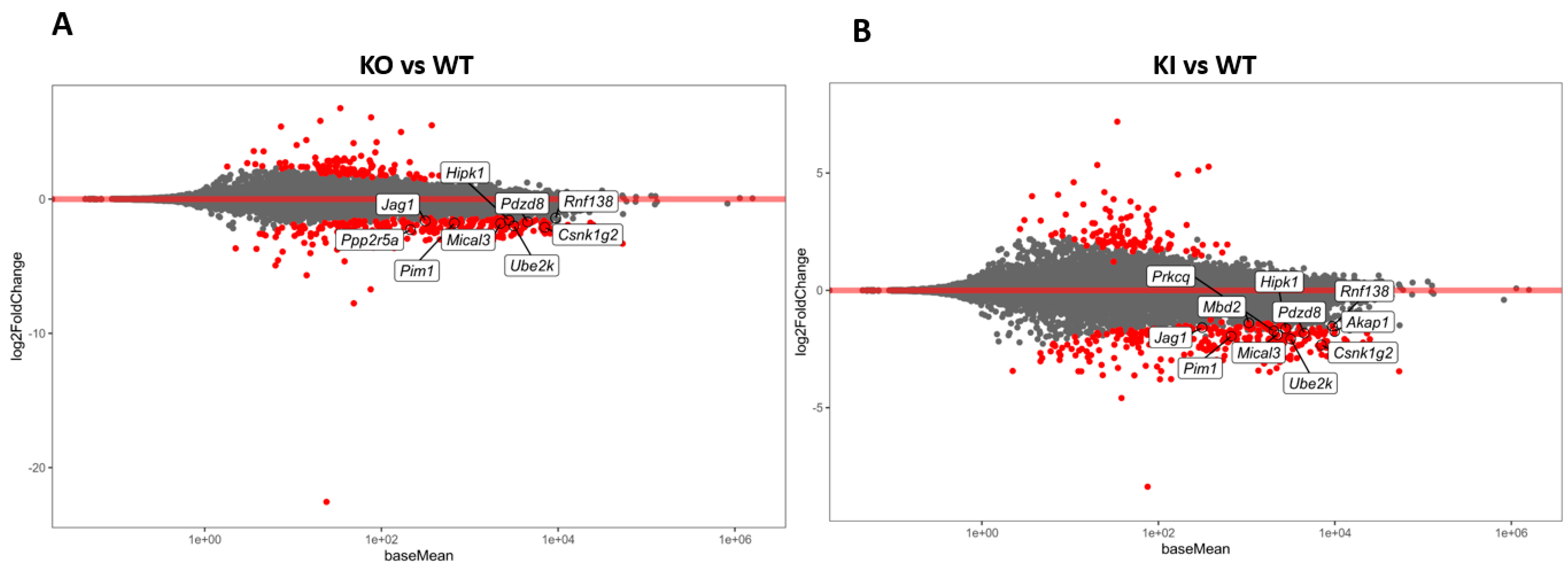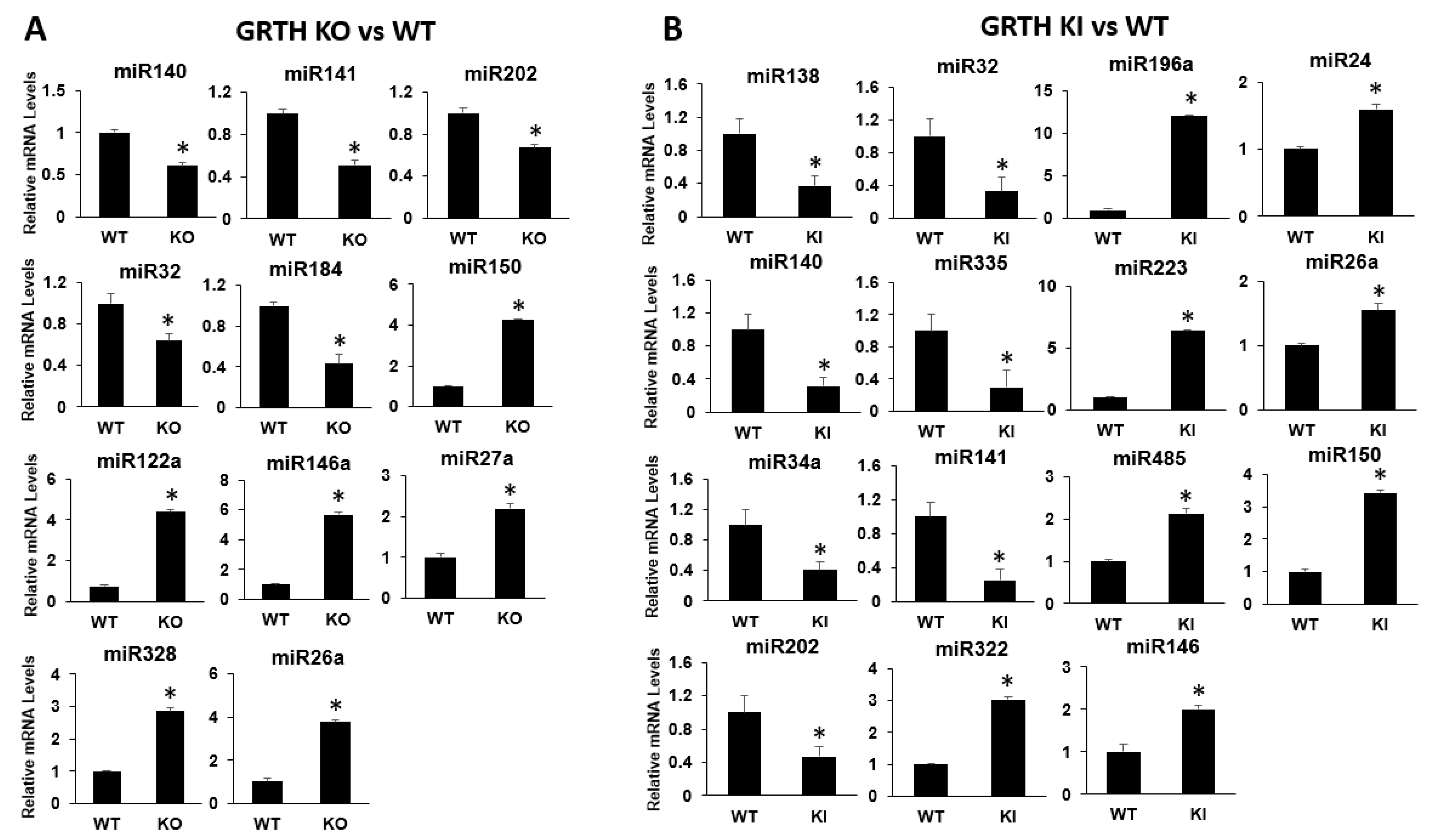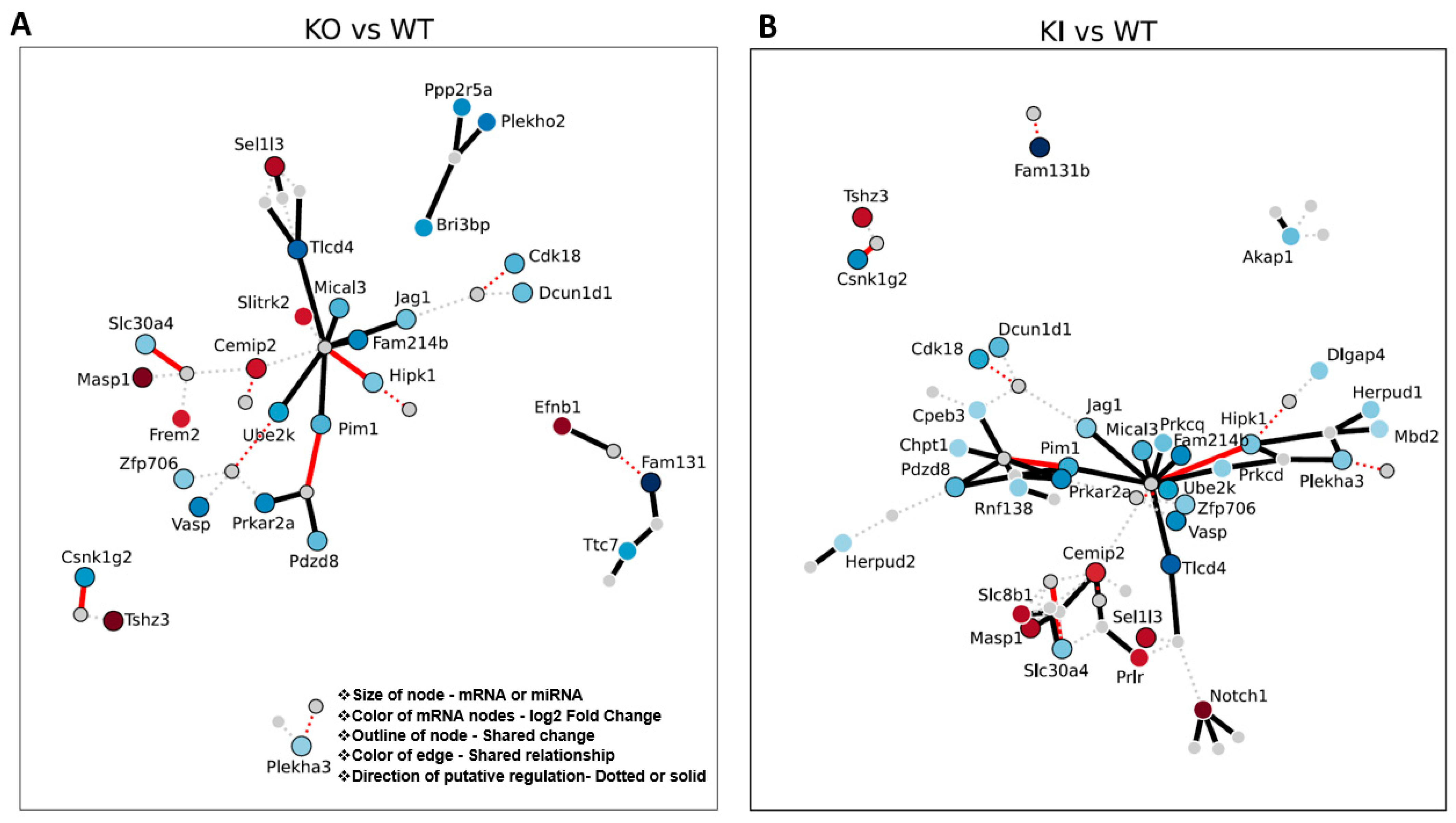miRNA Expression Profiles of Mouse Round Spermatids in GRTH/DDX25-Mediated Spermiogenesis: mRNA–miRNA Network Analysis
Abstract
1. Introduction
2. Materials and Methods
2.1. Animals
2.2. Isolation of RS from Mice Seminiferous Tubules
2.3. mRNA Libraries and Sequencing
2.4. mRNA-seq Data and Differential Expression of Genes (DEGs)
2.5. Gene Ontology (GO) and Pathway Analysis
2.6. Validation of mRNA-seq Data
2.7. miRNA Libraries and Sequencing
2.8. miRNA-seq Data and Differential Abundance of miRNAs
2.9. Validation of miRNA-seq Data
2.10. Identification of DE-miRNA–mRNA Target Genes
2.11. mRNA–miRNA Interaction Network Analysis
2.12. mRNA–miRNA Interaction—Luciferase Assay
2.13. Statistical Analyses
3. Results
3.1. Transcriptome Analysis of RS from KO, KI, and WT Mice Reveal Unique RS mRNA Signatures
3.2. Functional Gene Enrichment Analysis of DEGs from RS Transcriptomic Data
3.3. Validation of DEGs from mRNA-seq Data Reveals Comparable Transcriptomic Profiles
3.4. miRNA-seq Profiles of RS from KO, KI, and WT Mice Reveal miRNAs Targeting Spermatid Differentiation Process
3.5. Validation of Differential Gene Expression Analysis of miRNAs Using qRT-PCR
3.6. Correlation of mRNA–miRNA Interaction to Understand Network of Interactions
3.7. mRNA–miRNA Interaction Network Reveals Canonical mRNA–miRNA Role in Ubiquitination and Chromatin Compaction
3.8. mRNA–miRNA Interaction: miR122a Regulates Tnp2 Expression by Binding to Its 3′UTR
4. Discussion
Supplementary Materials
Author Contributions
Funding
Institutional Review Board Statement
Informed Consent Statement
Data Availability Statement
Acknowledgments
Conflicts of Interest
References
- Kimmins, S.; Sassone-Corsi, P. Chromatin remodelling and epigenetic features of germ cells. Nature 2005, 434, 583–589. [Google Scholar] [CrossRef]
- Steger, K. Haploid spermatids exhibit translationally repressed mRNAs. Anat. Embryol. 2001, 203, 323–334. [Google Scholar] [CrossRef]
- Kotaja, N.; Sassone-Corsi, P. The chromatoid body: A germ-cell-specific RNA-processing centre. Nat. Rev. Mol. Cell Biol. 2007, 8, 85–90. [Google Scholar] [CrossRef]
- Anbazhagan, R.; Kavarthapu, R.; Dufau, M.L. Role of phosphorylated gonadotropin-regulated testicular RNA helicase (GRTH/DDX25) in the regulation of germ cell specific mRNAs in chromatoid bodies during spermatogenesis. Front. Cell Dev. Biol. 2020, 8, 580019. [Google Scholar] [CrossRef] [PubMed]
- Tsai-Morris, C.H.; Sheng, Y.; Lee, E.; Lei, K.J.; Dufau, M.L. Gonadotropin regulated testicular RNA helicase (GRTH/DDX25) is essential for spermatid development and completion of spermatogenesis. Proc. Natl. Acad. Sci. USA 2004, 101, 6373–6378. [Google Scholar] [CrossRef] [PubMed]
- Tsai-Morris, C.H.; Koh, E.; Sheng, Y.; Maeda, Y.; Gutti, R.; Namiki, M.; Dufau, M.L. Polymorphism of the GRTH/DDX25 gene in normal and infertile Japanese men: A missense mutation associated with loss of GRTH phosphorylation. Mol. Hum. Reprod. 2007, 13, 887–892. [Google Scholar] [CrossRef] [PubMed]
- Kavarthapu, R.; Anbazhagan, R.; Raju, M.; Morris, C.T.; Pickel, J.; Dufau, M.L. Targeted knock-in mice with a human mutation in GRTH/DDX25 reveals the essential role of phosphorylated GRTH in spermatid development during spermatogenesis. Hum. Mol. Genet. 2019, 28, 2561–2572. [Google Scholar] [CrossRef]
- Kavarthapu, R.; Anbazhagan, R.; Pal, R.; Dufau, M.L. Single cell transcriptomic profiling of testicular germ cells reveals important role of phosphorylated GRTH/DDX25 in round spermatid differentiation and acrosome biogenesis during spermiogenesis. Int. J. Mol. Sci. 2023, 24, 3127. [Google Scholar] [CrossRef]
- Anbazhagan, R.; Kavarthapu, R.; Dufau, M.L. Chromatoid Bodies in the Regulation of Spermatogenesis: Novel Role of GRTH. Cells 2022, 11, 613. [Google Scholar]
- Sato, H.; Tsai-Morris, C.H.; Dufau, M.L. Relevance of gonadotropin-regulated testicular RNA helicase (GRTH/DDX25) in the structural integrity of the chromatoid body during spermatogenesis. Biochim. Biophys. Acta 2010, 1803, 534–543. [Google Scholar] [CrossRef]
- Dai, L.; Tsai-Morris, C.H.; Sato, H.; Villar, J.; Kang, J.H.; Zhang, J.; Dufau, M.L. Testis-specific miRNA-469 up-regulated in gonadotropin-regulated testicular RNA helicase (GRTH/DDX25)-null mice silences transition protein 2 and protamine 2 messages at sites within coding region: Implications of its role in germ cell development. J. Biol. Chem. 2011, 286, 44306–44318. [Google Scholar] [CrossRef]
- Chen, X.; Li, X.; Guo, J.; Zhang, P.; Zeng, W. The roles of microRNAs in regulation of mammalian spermatogenesis. J. Anim. Sci. Biotechnol. 2017, 8, 35. [Google Scholar] [CrossRef]
- Yao, C.C.; Liu, Y.; Sun, M.; Niu, M.H.; Yuan, Q.Q.; Hai, Y.A.; Guo, Y.; Chen, Z.; Hou, J.M.; Liu, Y.; et al. MicroRNAs and DNA methylation as epigenetic regulators of mitosis, meiosis and spermiogenesis. Reproduction 2015, 150, 25–34. [Google Scholar] [CrossRef] [PubMed]
- Bartel, D. Metazoan microRNAs. Cell 2018, 173, 20–51. [Google Scholar] [CrossRef] [PubMed]
- Vashisht, A.; Gahlay, G.K. Using miRNAs as diagnostic biomarkers for male infertility: Opportunities and challenges. Mol. Hum. Reprod. 2020, 26, 199–214. [Google Scholar] [CrossRef]
- Walker, W.H. Regulation of mammalian spermatogenesis by miRNAs. Semin. Cell Dev. Biol. 2022, 121, 24–31. [Google Scholar] [CrossRef]
- Joshi, M.; Andrabi, S.W.; Yadav, R.K.; Sankhwar, S.N.; Gupta, G.; Rajender, S. Qualitative and quantitative assessment of sperm miRNAs identifies hsa-miR-9-3p, hsa-miR-30b-5p and hsa-miR-122-5p as potential biomarkers of male infertility and sperm quality. Reprod. Biol. Endocrinol. 2022, 20, 122. [Google Scholar] [CrossRef] [PubMed]
- Papaioannou, M.D.; Pitetti, J.L.; Ro, S.; Park, C.; Aubry, F.; Schaad, O.; Vejnar, C.E.; Kühne, F.; Descombes, P.; Zdobnov, E.M.; et al. Sertoli cell Dicer is essential for spermatogenesis in mice. Dev. Biol. 2009, 326, 250–259. [Google Scholar] [CrossRef]
- Kotaja, N.; Bhattacharyya, S.N.; Jaskiewicz, L.; Kimmins, S.; Parvinen, M.; Filipowicz, W.; Sassone-Corsi, P. The chromatoid body of male germ cells: Similarity with processing bodies and presence of Dicer and microRNA pathway components. Proc. Natl. Acad. Sci. USA 2006, 103, 2647–2652. [Google Scholar] [CrossRef]
- Da Ros, M.; Lehtiniemi, T.; Olotu, O.; Meikar, O.; Kotaja, N. Enrichment of pachytene spermatocytes and spermatids from mouse testes using standard laboratory equipment. J. Vis. Exp. 2019, 151, e60271. [Google Scholar]
- Wang, L.; Wang, S.; Li, W. RSeQC: Quality control of RNA-seq experiments. Bioinformatics 2012, 28, 2184–2185. [Google Scholar] [CrossRef]
- Ewels, P.; Magnusson, M.; Lundin, S.; Käller, M. MultiQC: Summarize analysis results for multiple tools and samples in a single report. Bioinformatics 2016, 32, 3047–3048. [Google Scholar] [CrossRef]
- Martin, M. Cutadapt removed adapter sequences from high-throughput sequencing reads. EMBnet. J. 2011, 17, 10–12. [Google Scholar] [CrossRef]
- Dobin, A.; Davis, C.A.; Schlesinger, F.; Drenkow, J.; Zaleski, C.; Jha, S.; Batut, P.; Chaisson, M.; Gingeras, T.R. STAR: Ultrafast universal RNA-seq aligner. Bioinformatics 2013, 29, 15–21. [Google Scholar] [CrossRef]
- Liao, Y.; Smyth, G.K.; Shi, W. FeatureCounts: An efficient general purpose program for assigning sequence reads to genomic features. Bioinformatics 2014, 30, 923–930. [Google Scholar] [CrossRef]
- Stephens, M. False discovery rates: A new deal. Biostatistics 2016, 18, 275–294. [Google Scholar] [CrossRef] [PubMed]
- Langmead, B.; Salzberg, S.L. Fast gapped-read alignment with Bowtie2. Nat. Methods 2012, 9, 357–359. [Google Scholar] [CrossRef] [PubMed]
- Ziemann, M.; Kaspi, A.; El-Osta, A. Evaluation of microRNA alignment techniques. RNA 2016, 22, 1120–1138. [Google Scholar] [CrossRef]
- Agarwal, V.; Bell, G.W.; Nam, J.W.; Bartel, D.P. Predicting effective microRNA target sites in mammalian mRNAs. eLife 2015, 4, e05005. [Google Scholar] [CrossRef] [PubMed]
- Sethupathy, P.; Corda, B.; Hatzigeorgiou, A.G. TarBase: A comprehensive database of experimentally supported animal microRNA targets. RNA 2006, 12, 192–197. [Google Scholar] [CrossRef] [PubMed]
- Chen, Y.; Wang, X. miRDB: An online database for prediction of functional microRNA targets. Nucleic Acids Res. 2020, 48, 127–131. [Google Scholar] [CrossRef]
- Kavarthapu, R.; Anbazhagan, R.; Sharma, A.K.; Shiloach, J.; Dufau, M.L. Linking Phospho-Gonadotropin Regulated Testicular RNA Helicase (GRTH/DDX25) to Histone Ubiquitination and Acetylation Essential for Spermatid Development during Spermiogenesis. Front. Cell Dev. Biol. 2020, 8, 310. [Google Scholar] [CrossRef]
- Ismail, I.H.; Gagne, J.P.; Genois, M.M.; Strickfaden, H.; McDonald, D.; Xu, Z.; Poirier, G.G.; Masson, J.-Y.; Hendzel, M.J. The RNF138 E3 ligase displaces Ku to promote DNA end resection and regulate DNA repair pathway choice. Nat. Cell. Biol 2015, 17, 1446–1457. [Google Scholar] [CrossRef]
- Xu, L.; Lu, Y.; Han, D.; Yao, R.; Wang, H.; Zhong, S.; Luo, Y.; Han, R.; Li, K.; Fu, J.; et al. Rnf138 deficiency promotes apoptosis of spermatogonia in juvenile male mice. Cell Death Dis. 2017, 8, e2795. [Google Scholar] [CrossRef]
- Rathke, C.; Baarends, W.M.; Awe, S.; Renkawitz-Pohl, R. Chromatin dynamics during spermiogenesis. Biochim. Biophys. Acta 2014, 1839, 155–168. [Google Scholar] [CrossRef] [PubMed]
- Sheng, K.; Liang, X.; Huang, S.; Xu, W. The role of histone ubiquitination during spermatogenesis. Biomed. Res. Int. 2014, 2014, 870695. [Google Scholar] [CrossRef] [PubMed]
- Fatima, A.; Irmak, D.; Noormohammadi, A.; Rinschen, M.M.; Das, A.; Leidecker, O.; Schindler, C.; Sánchez-Gaya, V.; Wagle, P.; Pokrzywa, W.; et al. The ubiquitin-conjugating enzyme UBE2K determines neurogenic potential through histone H3 in human embryonic stem cells. Commun. Biol. 2020, 3, 262. [Google Scholar] [CrossRef]
- Shirakata, Y.; Hiradate, Y.; Inoue, H.; Sato, E.; Tanemura, K. Histone H4 modification during mouse spermatogenesis. J. Reprod. Dev. 2014, 60, 383–387. [Google Scholar] [CrossRef]
- Boa, J.; Bedfors, M.T. Epigenetic regulation of the histone-to-protamine transition during spermiogenesis. Reproduction 2016, 151, 55–70. [Google Scholar]
- Vatin, M.; Girault, M.-S.; Firlej, V.; Marchiol, C.; Ialy-Radio, C. Identification of a New QTL region on mouse chromosome 1 responsible for male hypofertility: Phenotype characterization and candidate genes. Int. J. Mol. Sci. 2020, 21, 8506. [Google Scholar] [CrossRef] [PubMed]
- Girault, M.S.; Dupuis, S.; Ialy-Radio, C.; Stouvenel, L.; Viollet, C.; Pierre, R.; Favier, M.; Ziyyat, A.; Barbaux, S. Deletion of the Spata3 gene induces sperm alterations and In vitro Hypofertility in Mice. Int. J. Mol. Sci. 2021, 22, 1959. [Google Scholar] [CrossRef] [PubMed]
- Wu, Q.; Song, R.; Yan, W. SPATA3 and SPATA6 Interact with KLHL10 and participate in spermatogenesis. Biol. Reprod. 2010, 83, 177. [Google Scholar] [CrossRef]
- Wang, S.; Zheng, H.; Esaki, Y.; Kelly, F.; Yan, W. Cullin3 is a KLHL10-interacting protein preferentially expressed during late spermiogenesis. Biol. Reprod. 2006, 74, 102–108. [Google Scholar] [CrossRef]
- Garcia, T.X.; Parekh, P.; Gandhi, P.; Sinha, K.; Hofmann, M.C. The NOTCH ligand JAG1 regulates GDNF expression in Sertoli cells. Stem Cells Dev. 2017, 26, 585–598. [Google Scholar] [CrossRef]
- Ma, J.; Fan, Y.; Zhang, J.; Feng, S.; Hu, Z.; Qiu, W.; Long, K.; Jin, L.; Tang, Q.; Wang, X.; et al. Testosterone-Dependent miR-26a-5p and let-7g-5p Act as Signaling Mediators to Regulate Sperm Apoptosis via Targeting PTEN and PMAIP1. Int. J. Mol. Sci. 2018, 19, 1233. [Google Scholar] [CrossRef]
- Norioun, H.; Motovali-Bashi, M.; Javadirad, S.M. Hsa-miR-27a-3p overexpression in men with nonobstructive azoospermia: A case-control study. Int. J. Reprod. Biomed. 2020, 18, 961–968. [Google Scholar] [CrossRef]
- Okada, Y.; Scott, G.; Ray, M.K.; Mishina, Y.; Zhang, Y. Histone demethylase JHDM2A is critical for Tnp1 and Prm1 transcription and spermatogenesis. Nature 2007, 450, 119–123. [Google Scholar] [CrossRef] [PubMed]
- Javadirad, S.M.; Hojati, Z.; Ghaedi, K.; Nasr-Esfahani, M.H. Expression ratio of histone demethylase KDM 3A to protamine-1 mRNA is predictive of successful testicular sperm extraction in men with obstructive and non-obstructive azoospermia. Andrology 2016, 4, 492–499. [Google Scholar] [CrossRef] [PubMed]
- Rinaldi, L.; Sepe, M.; Delle Donne, R.; Conte, K.; Arcella, A.; Borzacchiello, D.; Amente, S.; De Vita, F.; Porpora, M.; Garbi, C.; et al. Mitochondrial AKAP1 supports mTOR pathway and tumor growth. Cell Death Dis. 2017, 8, e2842. [Google Scholar] [CrossRef] [PubMed]








| Rnf138 | Ring Finger Protein 138, E3 ubiquitin-protein ligase involved in DNA damage response, highly expressed in spermatogonia and spermatocytes. Rnf138 deficiency promotes apoptosis of spermatogonia in male mice |
| Ube2k | Ubiquitin conjugating enzyme E2 K, interact with Ring finger proteins, Ube2k deficiency cause failure of germ cells to undergo meiosis results in male infertility |
| Csnk1g2 | Casein Kinase 1 Gamma 2, enables protein serine/threonine kinase activity, involved in peptidyl-serine phosphorylation, CSNK1G2-attenuated necroptosis mediate testis-aging program, CSNK1G2-knockout mice showed significantly enhanced necroptosis response and premature aging of testis |
| Hipk1 | Homeodomain-interacting protein kinase 1, phosphorylates homeodomain transcription factors (acts as co-repressor) |
| Pim1 | Encodes for the serine/threonine kinase, role in regulation of DNA damage repair |
| Jag1 | NOTCH ligand, JAG1 regulates GDNF expression in Sertoli cells |
| Mical3 | Microtubule-Associated Monooxygenase, Calponin, and LIM Domain Containing 3, MICAL3 work together in the process of docking and fusing of vesicles that are involved in exocytosis |
| Pdzd8 | PDZ domain containing 8, cytoskeletal regulatory protein that interacts with moesin and regulates stable microtubule abundance, acrosome stability. |
| Ppp2r5a | Major Ser/Thr phosphatases, role in negative control of cell growth and division |
| Akap1 | A-kinase anchoring protein, role in Star production and steroidogenesis |
| Mbd2 | Methyl-CpG Binding Domain Protein 2, |
| Prkcq | Protein kinase C theta, member of serine/threonine kinases, critically regulates cell growth and survival, mutation leads to male infertility |
Disclaimer/Publisher’s Note: The statements, opinions and data contained in all publications are solely those of the individual author(s) and contributor(s) and not of MDPI and/or the editor(s). MDPI and/or the editor(s) disclaim responsibility for any injury to people or property resulting from any ideas, methods, instructions or products referred to in the content. |
© 2023 by the authors. Licensee MDPI, Basel, Switzerland. This article is an open access article distributed under the terms and conditions of the Creative Commons Attribution (CC BY) license (https://creativecommons.org/licenses/by/4.0/).
Share and Cite
Anbazhagan, R.; Kavarthapu, R.; Dale, R.; Campbell, K.; Faucz, F.R.; Dufau, M.L. miRNA Expression Profiles of Mouse Round Spermatids in GRTH/DDX25-Mediated Spermiogenesis: mRNA–miRNA Network Analysis. Cells 2023, 12, 756. https://doi.org/10.3390/cells12050756
Anbazhagan R, Kavarthapu R, Dale R, Campbell K, Faucz FR, Dufau ML. miRNA Expression Profiles of Mouse Round Spermatids in GRTH/DDX25-Mediated Spermiogenesis: mRNA–miRNA Network Analysis. Cells. 2023; 12(5):756. https://doi.org/10.3390/cells12050756
Chicago/Turabian StyleAnbazhagan, Rajakumar, Raghuveer Kavarthapu, Ryan Dale, Kiersten Campbell, Fabio R. Faucz, and Maria L. Dufau. 2023. "miRNA Expression Profiles of Mouse Round Spermatids in GRTH/DDX25-Mediated Spermiogenesis: mRNA–miRNA Network Analysis" Cells 12, no. 5: 756. https://doi.org/10.3390/cells12050756
APA StyleAnbazhagan, R., Kavarthapu, R., Dale, R., Campbell, K., Faucz, F. R., & Dufau, M. L. (2023). miRNA Expression Profiles of Mouse Round Spermatids in GRTH/DDX25-Mediated Spermiogenesis: mRNA–miRNA Network Analysis. Cells, 12(5), 756. https://doi.org/10.3390/cells12050756







